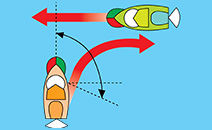Paddling Safe Practices
- Keep 3 points of contact and stay low getting into or onto your craft.
- If you fall out... in a current keep feet up on surface and swim to shore.
- If you capsize, hold on to your boat, unless it presents a life-threatening situation.
- Be prepared to swim. If the water looks too hazardous to swim in, don’t go paddling.
- Scout ahead whenever possible. Know the river/waterbody.
- Be prepared for the weather. Get a forecast before you go.
- Wear wading shoes or tennis shoes with wool, polypropylene, pile, or neoprene socks.
- Never take your boat over a low-head dam. Carry (portage) your boat around water you are uncertain of.
- Never boat alone.
- Keep painter lines (ropes tied to the bow) and any other ropes coiled and secured.
- Never tie a rope to yourself or to another paddler, especially a child.
- Kneel to increase your stability before entering rougher water, like a rapid.
- If you collide with an obstruction, lean toward it.
Make a Float Plan
A written statement that details your intended trip and is provided to a relative, friend, neighbor, or marina operator. Include specifics about the boat, equipment, crew, and departure and arrival times.
Hazards
Paddlers are susceptible to the same hazards as boats with motors like waterway obstructions and weather conditions. Paddlers smaller vessels are especially susceptible to conditions that can force the paddler off-balance and to capsize. Steer clear of strainers (anything that blocks passage but lets water through like fallen trees. NEVER try to steer over a low-head dam. And remember to keep your weight balanced over the center of your kayak, canoe or paddleboard.

Hazards on the Water
Hazards on the Water



